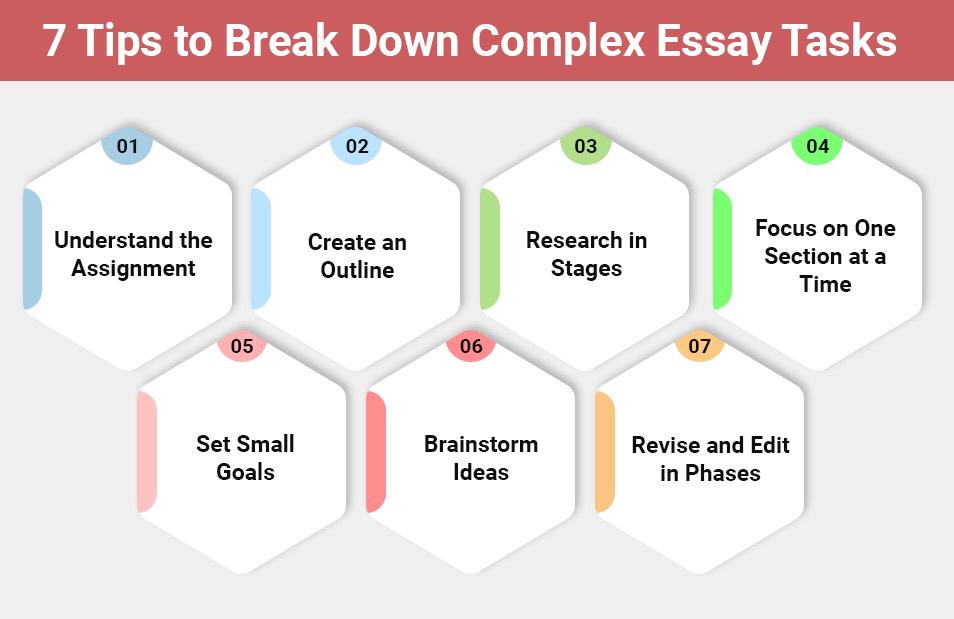Writing something can be frustrating, especially when it is time-consuming. Therefore, it is very important to break down the difficult task into manageable parts. To make the writing process more approachable and less intimidating, students should break down the essay task into smaller, more manageable chunks.
Students should discuss, explain, and rewrite their papers so that they can remain organised and clear throughout. This approach also helps improve time management by providing sufficient time for each step of the writing process.
This comprehensive guide gives you some tips for breaking down a complex writing task into smaller chunks. But first, let’s find out what the breakdown of essays is.
What is the Breakdown of the Essays?
Essay breakdown is the process of breaking down complex text into small parts to make the writing process easier. The various stages of writing, such as idea development, presentation, writing, revision, and editing, can all be highlighted in the breakdown process. Using a systematic approach assures a cohesive essay, and helps writers manage each section more effectively.
7 Tips to Break Down Complex Essay Tasks
Whether you’re writing a good introduction or incorporating a powerful argument into the body, you can effectively handle any section with the following techniques. Breaking down the essay task reduces stress and creates a more polished and coherent final story.
However, failing to adhere to the methodology can result in a rushed and chaotic paper, hindering its timely delivery and polished document. Therefore, to avoid this issue, students turn to reliable essay writing companies in the UK for help with their writing tasks.
However, here we are exploring some tips to make your paper easy to write.

1. Understand the Topic
Breaking down the essay topic into manageable parts is essential to comprehend the theme. There are a few important key points in this process that will allow you to approach the task with confidence and have a perfectly structured article.
- Research thoroughly to identify the title, general requirements, and any restrictions or recommendations.
- Analyse the presentation (e.g., argument, comparison, analysis) and determine the type of essay.
- Make sure you know exactly what questions or problems you need to answer in the paper.
- Note any special requirements for citation or formatting.
- Make sure the thesis statement is clear, argumentative, and relevant.
2. Create an Outline
Outlining is a useful way of breaking down the task into smaller chunks. The outline acts as a road map, helping you stay on task and focus on controversial issues throughout the paper. Writers can facilitate a logical essence of information and make it simpler to build each paragraph logically by way of essay planning. A defined outline makes it possible to identify gaps in the arguments or research, giving the writer a clear approach to observe as they write.
How to Create an Outline?
- Analyse the subject carefully and note important information including the title, any conditions that must be met, and any restrictions.
- Write down reasoning and any relevant evidence that comes to mind.
- Group the interconnected ideas and order them according to their importance and relevance.
- Focus on a chronological structure, including main points and supporting information.
- Make sure your plan meets the prompt and requirements by reviewing it, making the necessary adjustments and enhancing your writing skills.
Benefits of Crafting an Outline
- You can better understand the topic of the article and use the list to determine the most important elements needed for the answer.
- Students will be able to organise and incorporate their ideas, which will make sense of your and supporting arguments.
- You can save time by sticking to your plan and writing without looking for pointless research or distractions.
- If you follow the plan, your paper will be organised properly and each paragraph will be focused on one idea.
3. Research in Stages
Researching an article can be a daunting task, especially if the topic is complex or the deadline is approaching. Breaking down the essay task into sections to facilitate the process is necessary. By focusing on one area of study at a time, this approach allows you to create a well-structured and well-supported document that will cover all the important points.
Moreover, using this technique shows your understanding of the topic and your ability to think critically and analytically. Yet, many students do not do enough research to collect evidence for their papers, so they fail to write a comprehensive document. If you are also one of them, in this case, we suggest you buy essays online and make your writing stand out.
Breaking the research process down into the following four steps will allow you to take the right approach and manage a written statement.
- Understanding the problem statement
- Collect references
- Testing and data integration
- Outlining
4. Focus on One Section at a Time
You can avoid feeling overwhelmed by the whole story and focus entirely on completing a story by breaking down the essay task. For example, if you start with an introduction, focus on developing an engaging introduction and a specific topic before tackling the body paragraphs and conclusions.
You can improve your content by focusing on one aspect at a time. This allows you to thoroughly test your argument and ensure that it is supported by relevant facts. In addition, this allows many parts of the story to flow into each other harmoniously.
5. Set Small Goals
One of the best ways to break down the essay task into manageable chunks is to set small goals. The essay should not be viewed as one big task but should be broken down into several parts like the introduction, body paragraph, and conclusion.
Moreover, students can set daily or weekly goals and focus on smaller, more manageable tasks, such as writing a paragraph or compiling a survey for a single area. This keeps you motivated and organised so you can constantly improve without drowning.
How to Set Your Goals?
- Divide the essay into three parts: introduction, body, and conclusion.
- Set measurable goals, such as completing one paragraph each day.
- Avoid multitasking and focus on your writing, research, or editing in isolation.
- Set a deadline for each part of the paper so you can stay on schedule.
- Reward small accomplishments to prevent burnout and maintain motivation.
6. Brainstorm Ideas
Brainstorming is an essential step in breaking down the essay task into smaller pieces. This calls for you to have multiple perspectives on the essay question, allowing you to discover a huge range of thoughts. Write down anything that comes to mind at the moment without taking stress about accuracy or structure.
Additionally, college students can include all viable examples, proofs, counterarguments, and arguments. They should make a list of their thoughts and organise them into similar issues or regions. So, this permits you to choose the most vital points to get some of the body paragraphs and will let you stay on the right track.
Also, ask yourself: Do I have enough information or evidence to support this claim? You can then sort the shapes in order of strength and cut out the poor ones. This approach assures that your essay will be focused and organised before you start writing and that you have a clear objective. Mindfulness tells us where to go next, helps you manage your workload and reduces complications.
7. Revise and Edit in Phases
The main methods of breaking down the essay task are revision and editing that needs to be done in stages. Focus on one part of the story rather than trying to finish it all at once.
Content Revision Phase
Limit the likeliness of these errors by having a look at the content first. Examine everything about the work and how it persuades its audience or not. In this step, you are considering moving sections, formulating your thesis statement, and finally ensuring all the body paragraphs have the required number of ideas.
Grammar Phase
During this phase, ideas or explanations are in order concerning examining grammatical errors. This goal is not easy to achieve as editing may tend to do so often.
Coherence and Flow
This step answers the ‘how and what’ and ‘analyses how the ideas flow from paragraph to paragraph and how the storyline logically develops from the beginning to the end. This task may be difficult, but sometimes, writing ideas almost chronologically is not workable.
Formatting and Citation Review Phase
Citations and closing checklist ensure proper formatting for incorporating in-text citations in any piece of writing that adheres to a specific style guide, such as APA or MLA.
Pausing at any stage of the writing process permits you to review the article from a different perspective, which makes it more comfortable to spot mistakes and review the final draft. This step-by-step approach ensures you ensure a comprehensive, excellent transition plan.
What are the 7 Elements of an Essay?
The following are the 7 essential components of an essay
- Compile research
- Outline your writing
- Introduction
- The body paragraphs
- The results
- Editing and proofreading
- Go it over again
Conclusion
Breaking down the essay task into manageable chunks is an important writing strategy. This approach not only encourages a more structured technique but also allows for deeper interaction with the content. Thus, it may result in a more cohesive and sophisticated final product.
Creating smaller goals, focusing on one section at a time, and using time management strategies can greatly improve writing and study skills. If you are still having problems comprehending these strategies, you can get assistance from UK-based expert essay writers. They offer helpful guidance to meet high standards and support your academic goals. Finally, by comprehending this article, students may craft a compelling paper that makes a clear and well-supported argument.







